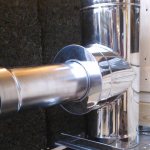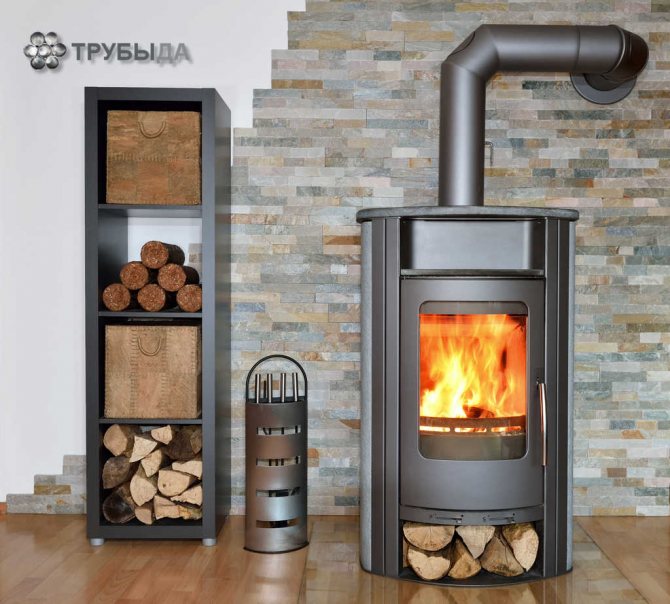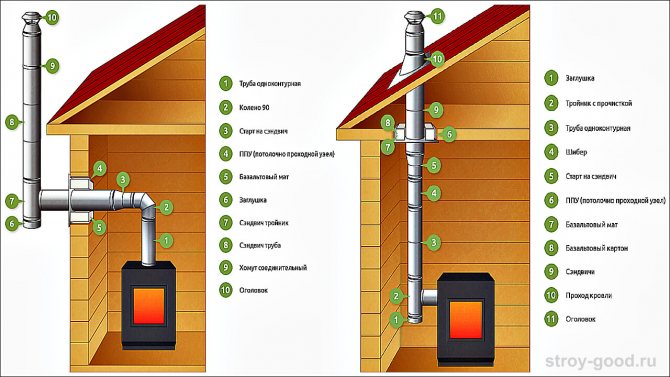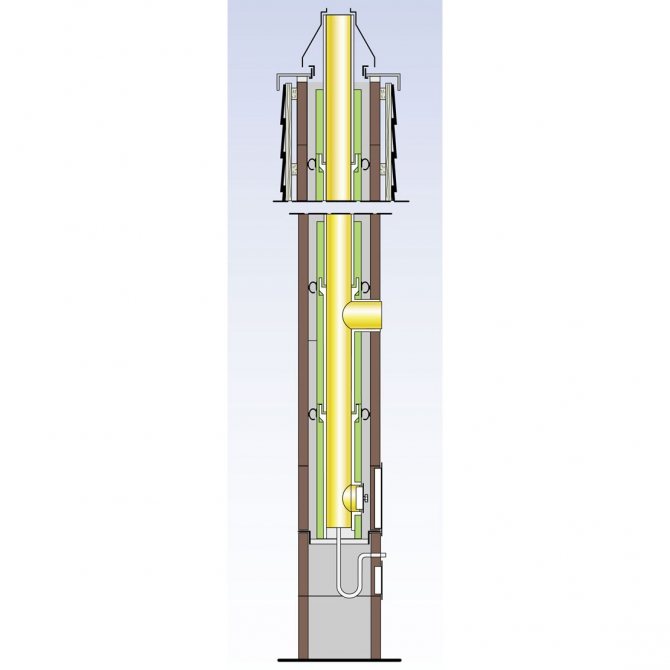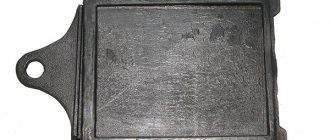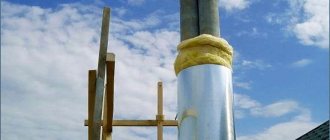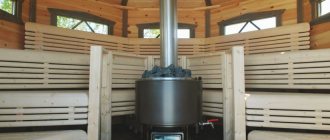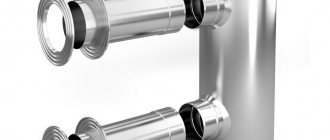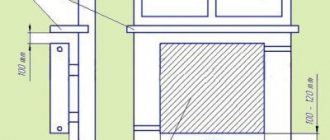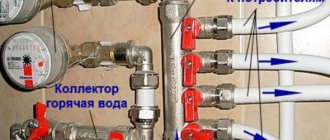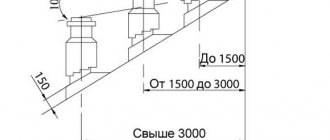10/25/2017 4535 Pechnik (Moscow) The horizontal chimney, in its structure, differs from the classic vertical structures that we are used to seeing. The most commonly used and installed systems are of the coaxial type, since they are distinguished by ease of installation (it is enough just to drill a hole of a suitable diameter in the wall, insert and fix the pipe, seal all gaps). By watching the video in this article and reading the selected information, you will learn more about what such exhaust systems are.
Chimney selection video
Conventionally, you can divide the chimney passage from the steam room to the street into three options:
- Chimney in the ceiling of the bath
- Chimney in the wall of the bath
- Chimney into the wall of the bathhouse and further through the roof overhang

A chimney running vertically into the ceiling and through the roof of the bathhouse is considered the cheapest and most functional option. And also such chimneys are easiest to clean, if the design of the stove allows soot to fall directly into the firebox and ash pan, then you don't even need to make a sump. But there is one thing, but if you want to buy a chimney for a bath and will install it yourself, there is a high probability that you will not be able to safely and most importantly pass the ceiling and roof tightly.
Making a hole in the wall for the chimney pipe is much easier and faster even for a beginner. For a stone wall, you can simply drill holes along the chimney markings and knock out the middle with a dexterous blow with a sledgehammer. For wooden baths, you need to use a chainsaw or jigsaw and do not forget to use fire-fighting elements of the chimney, such as roof and ceiling cuttings.
And finally, probably the most difficult and most expensive option for a chimney for a bath is passing through the wall and the overhang of the roof. In this case, it would be better to invite more experienced people for installation, they can be advised to you in the store or on the Internet. Alternatively, you can circle small overhangs using additional bends.


If you are going to build or assemble a chimney with your own hands, here are some tips and life hacks:
- A chimney length of 5 meters is optimal, but not more than 7 meters. Do not make long chimneys, because a wood-burning stove never burns evenly and it has periods of maximum burning, attenuation and complete absence of combustion with cooling and freezing of the chimney. Before the next trip to the bathhouse, you start heating and several temperature zones appear in the chimney, in the lower part it is already hot, and above it it is still cold and even frozen at the very top. Due to the temperature difference, the flue gases in the cold part begin to condense on the walls of the chimney and flow, mixing with soot, down to the hot areas, where they turn into very hard carbon deposits. Such carbon deposits cannot be cleaned with the chimney sweep's brushes, and over time, the chimney starts to work poorly, and then completely overgrows and requires a complete replacement. With a long chimney, the stove can stop working properly and your sauna can fill up with smoke and carbon monoxide.
- Do not make horizontal sections of the chimney longer than 1 meter, so as not to impair the draft of the chimney.
- Asbestos-cement pipes cannot be used as a chimney device in a bath. Such pipes are not environmentally friendly and emit toxic substances. Asbestos-cement pipes can ignite already at 300 degrees Celsius, and also tend to explode at the boundaries of the temperature difference, which is a constant component for the chimney.
- When choosing a stainless steel chimney sandwich, pay attention to how it is assembled.The upper inner pipe must be inserted into the lower inner pipe so that the condensate, flowing down, does not seep through the joints (assembly by condensation), and the upper outer pipe must be put on the lower outer pipe so that rain does not penetrate into the sandwich insulation (assembly by smoke).
- Single-pipe stainless steel chimneys should be collected only by condensation, do not be afraid that smoke will seep into the room through the joints. The joints need to be coated with a heat-resistant sealant, but even without it, the chimney is more likely to suck in air through the joints, rather than vice versa.

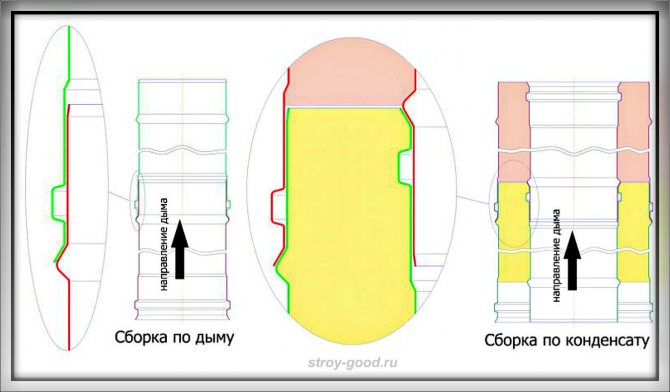
- Avoid kinks in the chimney, the straighter the chimney, the better its draft. Whenever possible, replace right-angle pivots with a pair of 45-degree pivots.
- Single-pipe chimneys for wood-burning stoves 0.8 - 1 mm thick are not crushed by hand, if crumpled, then these are pipes for ventilation.
- Cover the joints of stainless steel chimneys with black sealant 1100 - 1500 degrees.
- The diameter of the chimney should not be less than the diameter of the outlet of the furnace.
- The height of the chimney on a straight roof is 0.5 meters. How to calculate the height of the chimney on the ridge roof is shown in the diagram:


- If you have a small, one-story, freestanding bathhouse with an iron stove, then take a stainless steel chimney sandwich.
- If you have a large two-story bathhouse or a bathhouse in the basement of the house, buy a ceramic chimney or build a brick chimney with steel pipes.
- A brick chimney is justified only if you have a brick stove or fireplace.
Basic constructions ↑
Branch ducts through which the utilization of air saturated with combustion products passes is necessary not only for stoves, but also for fireplaces or heating boilers or gas water heaters.
We list the main types of chimneys for stoves.
- Direct-flow. This is one of the first systems through which combustion products were removed. They have a significant drawback - due to the non-stop removal of gases outside, the main part of the generated heat is carried away.
- Direct-flow structures equipped with transverse bridges. These small additions allow some of the heat to be retained. When heated, the lintels transfer heat to the walls of the heating unit. The same design is typical for a stove without a chimney in baths: the stones in them are heated by the hot combustion products.
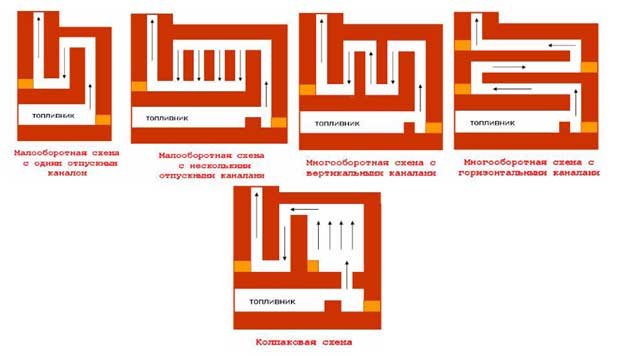

- With a "labyrinth". There are many varieties of such designs, but they all have common features. In particular, this concerns the rate of gas removal. It is quite low, since the exhaust gases are passed through a tortuous channel. In the process, the device itself is warmed up in parallel and maximum heat transfer is ensured.
- The now classic Russian stove. Chimney scheme - bell-type. The incandescent gas rises upward, cools a little on the inclined arch of the hearth, and descends to the channel. The disadvantage of such a system is that it warms up unevenly. For example, in the lower part of the hearth, it does not warm up at all, since the heat mainly goes to the vault.
- Modular. Unlike the classic brick version of smoke evacuation, they are made of metal. They are used in gas-fired heating systems. The fact is that the products of methane combustion are acidic compounds that destroy bricks with their aggressive effect.
Materials from which chimneys are made.
- Brick chimney in the bath
- Stainless steel sauna chimney
- Ceramic chimney for a bath
Chimneys for a brick bath are of two types:
- Root - erected next to the furnaces and connected with a pipe.
- Mounted - built directly on the brick oven and being its continuation.
Brick chimneys for a bath are not very justified, since these are very heavy structures, and they require a strong foundation for themselves.Also, if the masonry is not of high quality, excessive accumulation of soot is possible on the excess solution protruding from the seams, which, in turn, also complicate the high-quality cleaning of the chimney. For laying the chimney, use heat-resistant bricks and pay special attention to the tightness of each seam.
We conclude that a brick chimney is the most durable, but not an economical and labor-intensive type of chimney and is not suitable for a small, detached, wooden bath. It is advisable to erect it if you have a brick stove (top-mounted version), or when the chimney goes along the outer wall of the house and the appearance of the building requires this (root version). But in any case, you need to be completely sure - in the strength of your foundation.
Stainless steel chimneys are sold in stores in two versions, these are double-circuit sandwich chimneys (insulated) and single-walled (not insulated).
Single-walled, non-insulated pipes are used mainly for casing brick chimneys and for the first section of the chimney (it can be used to estimate the wear of the entire chimney). They look like and are assembled according to the pipe-socket principle, where the upper pipe is inserted into the socket of the lower pipe. Such chimneys are of high quality mirror stainless steel or galvanized steel.
Insulation thickness on insulated chimneys ranges from 30 to 100 mm. As a rule, basalt wool, which has high fire-fighting properties, is used as a heater.
The thickness of the stainless steel is from 0.5 to 1 mm, the design is lightweight and does not require large silos, powerful fasteners or foundation.
The flare system is a sealed connection. A large selection of fittings and fasteners makes chimney assembly simple and, most importantly, a quick task, even for a person who has never done this.
The passage of wooden floors, roofs and walls near such chimneys is carried out using special elements that isolate the chimney from wood and prevent fire.
Also, such chimneys are easy to clean and have an aesthetic appearance.
Chimney diameter from 80 to 300 mm. The absence of corrosion, as well as the ability to order (in many cities) individual production, makes the stainless steel sauna chimney the leader of this market.
Metal stoves with chimney
Metal furnaces are models that are most often made from high-quality cast iron alloys and its analogues. In the past, such products were known as "potbelly stoves", since for the first time they began to be actively used in Western countries. Thanks to the development of industry, a wide selection of such models has appeared in our country.
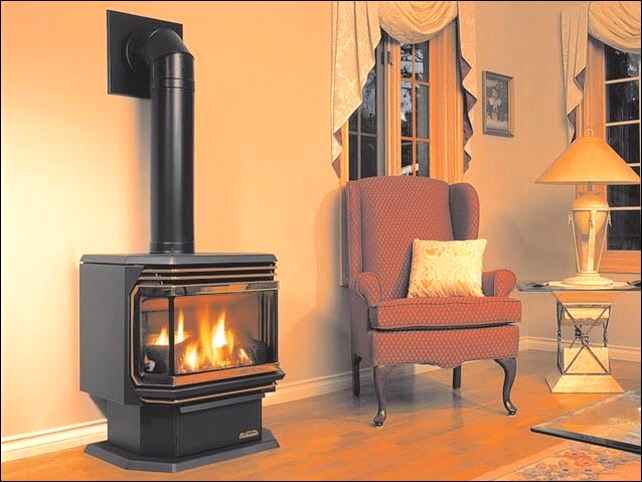

The main advantages of such stoves without a chimney are compactness and wide functionality, which is not limited to heating only. Thanks to the presence of special niches, cooking, drying clothes and much more is possible.
An important feature is the need to install a chimney, which performs similar functions as a chimney, but has a simpler structure. The chimney is a hollow metal pipe that simply removes the combustion products. There is no need for a complex device and additional components that protect the interior.
The design of the metal oven is both simple and ingenious. The internal firebox has a space where the fuel is directly burned. This section is practically no different from the classic firebox. Around it is a large number of semi-closed tubes that contain air. As the fuel burns, it heats up, which allows the accumulation of thermal energy, which significantly increases energy efficiency.
One should not forget about the high heat capacity of cast iron, from which such furnaces are usually produced.It cools down extremely slowly, which allows you to forget about the problem of the furnace furnace at night - the metal gradually cools down over 8-10 hours. All this is extremely convenient in the format of using the stove in the country or in a country house.
The product has a pleasant appearance and is suitable for many design trends. Forget what looks like a nightmare legacy of the past - many models have a large number of forged elements that make metal stoves without a chimney a real work of art.
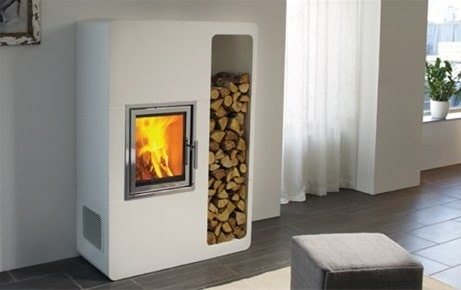

The number of manufacturers of metal furnaces is extremely large, so customers are forced to focus on the assortment that is available and the purchase budget. If you want to purchase a really high-quality, durable and visually attractive product, then you should pay attention to the products of the following manufacturers:
- EdilCamin (Italy);
- Corradi (Italy);
- Thorma (Slovakia);
- Biokaitra (Lithuania);
- Amur (Russia);
- Brandenburg (Russia);
- ABX Arktis (Czech Republic).
As can be noted, the choice is really great, so everyone will find a suitable option for themselves!
Chimney supplied with the stove
In most cases, when purchasing a wood-burning stove, a chimney system is supplied, ideally suited to this type of stove. You can install it both independently and with the involvement of third-party specialists. Moreover, the cost of such work is relatively low - it starts from 4-5 thousand rubles.
Structures can be made from a wide variety of materials, ranging from steel with a diameter usually from 9 to 20 mm. and ending with ceramic pipes. Moreover, it is the latter that are considered the safest and most durable. This is followed by chimneys made of stainless steel. The next on the level of quality - pipes "sandwich". Returning to steel pipes, the most preferred steel grade is AISI 310S, which has increased heat resistance.
The complete diagram of the "stove - chimney" design and related systems is as follows.
Particular attention is paid to the node of passage through the roof or through the wall, depending on the type of chimney design.
Ceramic chimneys
The next type of chimney is ceramic pipes, which are widespread nowadays. Such chimneys are made of durable ceramics, which are often additionally encased in bricks, expanded clay concrete or other refractory materials. Ceramic pipes are assembled like a brick chimney from separate blocks, which are interconnected into a single structure. Among the main advantages of ceramic pipes are their versatility - they can be used to connect any home heating appliances, they are also compatible with various fuels.
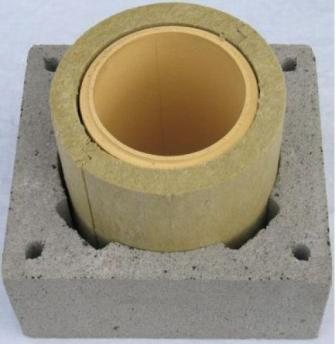

Since ceramic chimneys are assembled from separate blocks, during their installation it is possible to create different turns of the chimney line. The ceramic chimney has a high level of fire safety and durability. Among the disadvantages of ceramic chimneys, they are distinguished by their very high cost and large weight, which dictates the need to install a foundation. At the same time, the installation of such pipes is difficult - ceramic blocks must be assembled in a strict order, and special solutions and materials must be used to connect and seal them. Ceramic pipes are designed to withstand rather high temperatures of exhaust gases - up to about 1200 degrees Celsius.
We summarize the above-mentioned pros and cons of ceramic chimneys for removing combustion products from fireplaces and stoves:
Pros:
- long service life
- versatility
- compatibility with any home heating equipment
- high level of fire safety
- the ability to create high complexity smoke evacuation routes
Minuses
- high price
- heavy weight
- the need to build a foundation
- complex installation
- the need to use additional materials when laying
Chimney price


The price of a chimney is not less, and often much more expensive than the stove itself.
Let's compare the prices for stainless steel chimneys and ceramic chimneys with the following conditions:
- Chimney height 7 meters
- Internal chimney diameter 160 mm
- Chimney elements Base with condensate drain
- Revision
- T-piece for connecting 90 degrees
- Chimney
- Chimney head cone
Stainless steel chimney from 40 tr. up to 60 tr. chimney weight will be from 40 to 70 kg.
Ceramic chimney from 45 tr. up to 120 tr. chimney weight will be from 500 to 700 kg.
A brick chimney can only be calculated individually according to the project.
Brick chimney
The most "ancient" solution to the smoke evacuation system is brick chimneys, which have been used by mankind for many centuries in a row. Today, this solution for the removal of combustion products is also common, but it is considered outdated. Brick is a refractory material, but such properties are not sufficient for high-quality removal of combustion products from heating devices. The rough surface of the brick contributes to the rapid accumulation of soot and carbon deposits, and therefore, such pipes require frequent maintenance and service. The significant disadvantages of brick pipes include their high weight and long installation. To install a chimney of such a large weight, a special foundation is required, and the chimney will have to be erected literally "brick by brick". By the way, the brick itself is quite expensive, so a brick chimney is also an additional burden on the budget.
If the brick chimney is installed incorrectly, it can be fire hazardous, and condensation will appear inside it. At the same time, after some time, cracks may appear on the surface of the brickwork, which reduces the tightness of the chimney. Brick chimneys also have advantages. For example, the aesthetic characteristics of such chimneys are highly appreciated. The orange masonry of the brick chimney brings comfort to the house. They also emit an increased level of heat transfer from bricks along with good fire resistance. The brick chimney is designed to withstand flue gas temperatures of up to 600-700 degrees Celsius.
Summarizing the above, we highlight the main pros and cons of a brick chimney for removing combustion products from fireplaces and stoves.
Pros:
- nice appearance of brickwork in the interior
- excellent refractory properties
- accumulation and release of heat
Minuses:
- the need to install a foundation
- laborious and time-consuming installation
- the possibility of fire hazardous situations
- the possibility of cracking
- rapid formation of condensation, carbon deposits and soot on the inner walls of the chimney due to the rough surface
- high brick cost
How brick ovens with a water tank are laid
When installing a chimney, a furnace refractory brick should be used, laid on a mortar from special heat-resistant mixtures, or using a conventional clay-sand mortar, which is a more economical option that practically does not lose in the quality of the structure.
- An overhead tube installed on the furnace. It is equipped with a damper to regulate the flow of smoke. Masonry is carried out with the obligatory special binding of bricks.
- Fluffing. Starts 5-6 rows of bricks before overlap. The chimney cross-section remains unchanged, but outside it becomes wider by 25-40 cm.
- Riser. Part of a brick chimney running through the attic.
- Otter. Expansion of the chimney after entering the roof, preventing precipitation from entering the junction of the chimney and the roof.
- Neck. The dimensions are the same as for the main flue. An umbrella is installed on it.
Brick sauna stoves with a water tank can be of different designs. The common thing will be that the tank is located either above the firebox, or on the side of it, next to the stove.Usually, under the tank, which has a rectangular shape, a protrusion of appropriate dimensions is made.
For independent work on the construction of a brick oven, experience is needed. The “recipe” may sound simple, but that simplicity is deceiving. Read more about brick ovens here.
It all starts with the choice of design, and there are quite a few of them. When the choice is made and the orders are found (for example, on the Internet), the number of bricks and the weight of the furnace with all components are calculated - the depth of the foundation depends on this parameter. If the weight of the finished stove is more than 700 kg (and it will definitely be more and do not forget to enter the tank filled with water to the top), then the foundation is automatically required. Read about how the foundations for the furnaces are made on our website.
Having prepared the base, you can start laying. But first you need to prepare the correct solution.
IMPORTANT! No cement mortar is used for brickwork. Only clay and sand. There is also a masonry without mortar.
First you need to soak the clay. To do this, take equal amounts of water and clay and mix them. After a couple of days, wipe the solution through a fine grid (3x3 mm is fine). Then take the sand, sift it and add to the mixture so that you get something like thick sour cream. The masonry mortar should be neither too greasy nor too skinny.
Alternatively, you can buy a ready-made clay-sand mixture in bags at a hardware store, it is enough to dilute it with water and you can put the oven (follow the instructions on the bag).
We also recommend useful materials about stoves:
Well, the topic is fully disclosed so that you can decide on the choice of the desired type of tank, its volume and location. Success with installation!
Operating principle
Nothing complicated here. Water is one of the most heat-absorbing substances, so a lot of energy is needed to heat it. We can take this energy either from the furnace body or from the chimney.
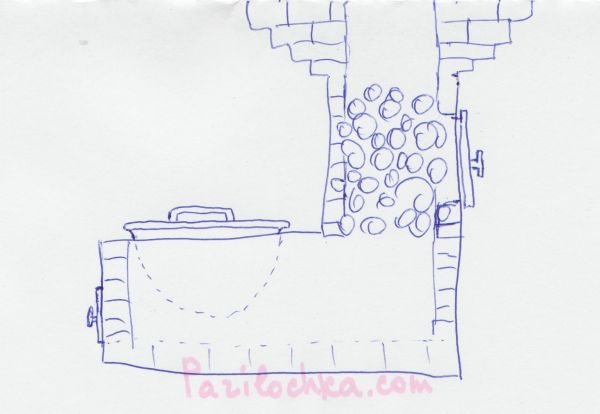

Brick stove for a bath with a water tank
It is clear that inside the stove the heat is "working", which goes to heat the steam room, but in the chimney it is already one of the losses, because the gases do not have time to cool down, passing through the pipe, and in this form they go into the atmosphere.
It follows from this that the idea of purchasing a stove for a bath with a water tank can be useful to increase the efficiency of the stove - for this you need to take a model with a tank on the chimney.
Chimney maintenance
When used correctly, condensation and ash deposits form in minimal quantities on the walls of the modular stainless steel chimney. However, during the combustion of various types of fuel, soot, creosote, weakly concentrated acid-containing compounds (condensate) are formed over time. Steel chimney manufacturers recommend that the chimney be inspected and cleaned at least once a year, at most twice a year: at the beginning and end of the heating season. Lack of timely maintenance of the chimney can lead to ignition of ash and soot in the internal circuit.
Pros and cons of different designs
Individual advantages may outweigh disadvantages, depending on the circumstances. It is clear that if the tank is located on the stove or attached to the side, then three unpleasant things follow from this:
- constant heating of water will lead to the formation of steam, but it will not be the steam heated above 100 degrees, which is called light - it is obtained only from overheated stones. And ordinary heavy steam will pour out of the container, from which it is difficult to be in the steam room.
- using heated water for washing is problematic if the steam room is not combined with the steam room. We'll have to carry hot water to the sink and wash the way our ancestors washed).
- in tanks attached to the side of the stove, heating occurs worst of all, because the walls of the stove do not warm up as much as the top or chimney.Plus, the wall of the tank itself will eventually lose its thermal conductivity due to scale, and the wall of the furnace - due to scale. Therefore, the water warms up poorly, it remains cold below, it must be mixed manually.
However, there are also advantages to such structures - they are easy to fill with water precisely because the container is not located high. But this is if there is no cold water supply either. Otherwise, the plus is leveled.
By the way! The larger the contact area of the container with water and the stove, the faster the heating. But this is not always worth striving for - why do you need clubs of heavy steam in an unheated bath?
Of course, you still have the opportunity to arrange a shower from any tank. And, although the stove-makers do not advise using the pump, the forced circulation of the liquid in the system will calmly take water from even the instructor, even from the attached tank. The main thing is not to forget to add.
In fact, we already answered this question in the previous chapter, but the answer referred to the specifics of a particular bath.
How to calculate the required volume of the container? Assume that one washer needs at least 10 liters of water.
How is it supposed to heat adjacent premises? If no other options are available, a remote reservoir can be used for this purpose. It goes without saying that in this case it is not worth insulating it. Alternatively, an oven can be used to heat the antifreeze in a separate heating system.
Are you ready to create forced circulation? If so, then there are no obstacles to choosing any of the described designs. In this case, you will receive not only a shower, but also, if desired, heating through radiators. True, you will have to organize the system according to all the rules.
For example, do not forget about the need to install an expansion tank that receives excess fluid in the system.
Why do you need a chimney?
A chimney is a special channel through which smoke, consisting of burnt fuel particles, is diverted from the heater to the street. Without a chimney, all smoke, carbon monoxide and particles, many of which are quite unhealthy, would simply remain indoors, posing a real threat to life. At the same time, it is the chimney that is responsible for the draft, which directly contributes to the combustion of fuel in the firebox of a fireplace or stove. It is difficult to overestimate the function of the chimney, just as it is difficult to overestimate the importance of the quality of execution and connection of the chimney. How well the chimney is made initially and how professionally it is connected to the heating device will subsequently affect the operation and safety of the entire heating system.
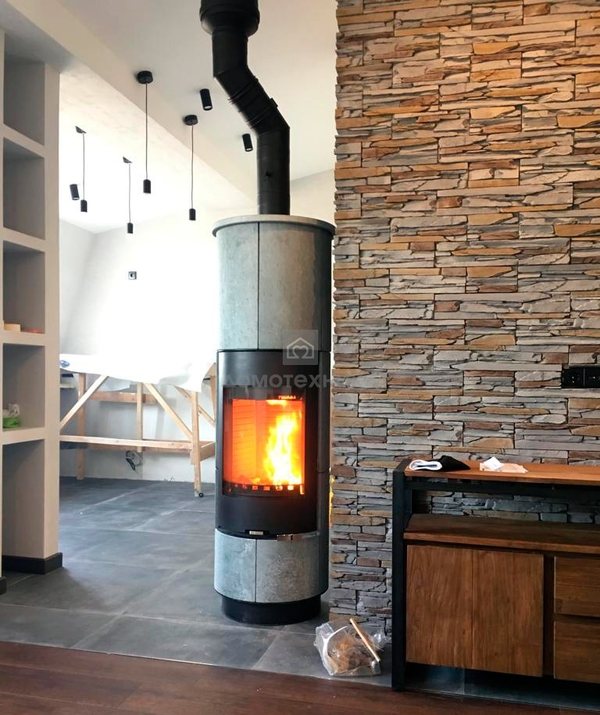

It is important to understand that heating products, due to differences in design and temperature of the exhaust smoke, require the installation of different chimneys. So what is the best chimney for a home fireplace or stove? This question will be answered in this article.
How to install a wood burning stove with a tank
If the stove is not homemade, then the details of its installation are described in the passport. Just in case, we recall that there is a significant difference between preparing for the installation of a metal stove and laying a brick.
Stove for a bath with water: heat exchanger on a pipe
In the first case, a relatively light foundation is made, without a separate foundation, which is designed to ensure both stability and fire safety. These are 1-3 rows of bricks, which are laid below the level of the finished floor.
A refractory sheet is placed on top of the base, followed by an iron sheet, significantly protruding in front of the firebox in order to avoid ignition from flying sparks.
If the firebox is remote, then the channel is led through the wall and must be thermally insulated. To do this, a gap is left between the channel and the wall, where a heat insulator is inserted (not any, but only one that can withstand very high temperatures). The wall itself is made of non-combustible material, such as brick.Read more about remote fireboxes here, you may also need material about portals and about fireplace stoves.
After installing the stove (see here and here), the chimney is mounted. This is a separate topic. We are only interested in the case when the tank is on the chimney. There is already a chimney inside it, so it is simply placed on the outlet section of the pipe from the stove, and a regular chimney is mounted on top.
In other cases, the tank is either put / hung on board, or pipes / hoses are attached to the fittings of the built-in heat exchanger, which will connect it to a remote tank fixed in the washing or dressing room.
Installing the tank should not be too difficult, especially when it is not a remote model. Hinged, as the name suggests, is simply hung with hooks on the side of the stove, the instructor is placed on top. The chimney tanks are simply placed on the outlet piece of the pipe from the stove. For greater reliability, it is worthwhile to provide for a more durable mount, if there is no desire to drop the tank weighing half a centner, or even more.
The remote tank may have wall-mount loops: watch the short video where they are shown.
Electric fireplaces
Speaking about the absence of a chimney, many often mean the absence of any pipe as such. Until recently, it was believed that stoves without a chimney were a pipe dream. Today, there are at least three ways to make this dream come true:
- electric fireplaces;
- bio fireplaces;
- tiled stoves.
The most popular is the use of electric fireplaces. This option is suitable for a summer residence, since you cannot count on a large heated area, and electricity will cope with heating a small house. The heating element in such a furnace is a nichrome spiral, which is placed in an insulated casing. The effect of heat transfer from such stoves is enhanced by the arrangement of convection channels, in which the air is efficiently heated and enters the room.
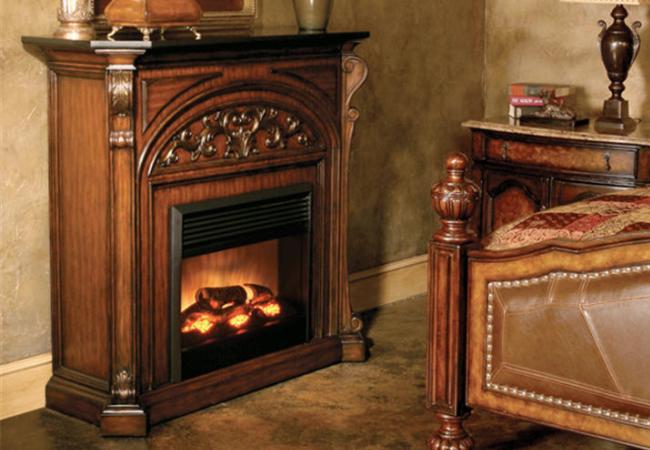

Electric fireplace option
Electric fireplaces do not need a chimney arrangement, with the exception of a dummy when creating a certain style. They simulate flames using a variety of technologies. The flame based on the work of the steam generator is a real miracle, since it is pleasant to admire it, and the three-dimensional image conveys all the magical power of living fire. Electric fireplaces or air heaters are the only possible heat source for a garage. Even the installation of a conventional solid fuel stove is difficult as it takes up precious space.
Good to know: Brick stove, how to build a combined device
Electric stoves and fireplaces, thanks to their simple installation, have gained popularity among apartment owners. The broad authority that a designer receives when decorating a room is further enhanced by the various layouts or finishes of the fireplace.
